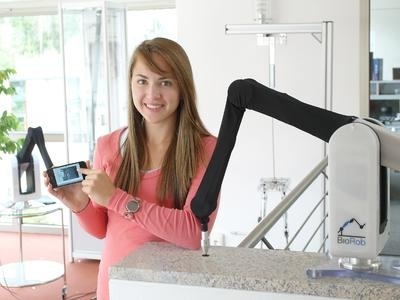A new way to develop MEMS

A novel methodology could pave the way for innovative sensors and actuators and robots which will be able to see and feel more effectively in the future
Edacentrum says the design of micro-electromechanical systems (MEMS) is about to undergo a technological revolution.
Experts from research institutions and industry are investigating entirely new methods for developing MEMS.
They are working together in the research project known as "Circuit Diagram-Based Design of MEMS for Applications in Optics and Robotics" "“ or MEMS2015 for short.
The image above shows a test of a "BioRob" arm with a smart phone, which would not exist without MEMS. With MEMS2015 only, MEMS devices can be developed, which are indispensable in future as a core of (robot) systems. (Source: TETRA GmbH Ilmenau (Photo by Andreas Karguth))
This project is funded by the Federal Ministry of Education and Research (BMBF) and coordinated by Robert Bosch GmbH.
The aim is to develop the first ever universal design methodology for MEMS to plug the gaps between electronics and mechanics design, manufacturing, and subsequent integration into products.
MEMS are tiny components that require a minimum of space to measure and electronically process parameters such as acceleration, pressure, distance, temperature, light, or chemical concentrations.
With their sophisticated, compact sensor and actuator systems, MEMS can for instance be used to ensure that airbags are inflated promptly before a car is involved in a collision, to measure blood pressure or oxygen content in intensive care applications, or to enable digital cameras to eliminate camera shake.
Potential 50 percent increase in the market for MEMS
The new development methods for MEMS will allow innovative sensor and actuator systems to be developed "“ providing robots, for instance, with more effective sight and touch in the future. What is more, the potential market for MEMS stands to increase by up to 50 percent as a result.
Using a type of modular system, the MEMS2015 researchers aim to plug the gaps between chip and sensor manufacturing on the one hand and the subsequent integration of the modules into products on the other.
This will substantially increase the opportunities for widespread use of MEMS in the professional and security-relevant segments. The new methods will also allow small and medium-sized enterprises to design MEMS and integrate them into their products much more often, as well as in a wider range of configurations than at present.
Projecting images directly onto the retina
These new development methods for MEMS will pave the way for entirely new solutions in the leading-edge applications of optics and robotics. This opens up the prospect of the wide-ranging use of micromirror arrays, similar to the devices already being used in projectors. This technology allows images to be projected directly onto the retina using special glasses.
In robotics, force sensors and profilometers can be developed that analyze surfaces even more accurately than before, or that simulate an extremely precise sense of touch. The project findings are being verified as part of the project on the basis of real MEMS prototypes which, in turn, serve as demonstrators.
"The project opens up innovations in mechanical engineering and process plant engineering by using powerful sensor and actuator systems based on groundbreaking MEMS and chip technologies," says Mirco Meiners, the project coordinator for MEMS2015 who works in the Bosch Automotive Electronics division.
"The clear focus of funding from Germany's Federal Ministry of Education and Research (BMBF) helps companies maintain their lead in innovation for key technology topics and develop new innovative, complex products."
"The MEMS2015 project raises the bar when it comes to the quality and especially the productivity of MEMS design," says Ralf Sommer, the scientific director of the Institut fuer Mikroelektronik- und Mechatronik-Systeme gemeinnuetzige GmbH, one of the eight partners in the project.
"Basic concepts such as circuit diagram-based design, which are already successfully used in microelectronics design, are now being transferred to MEMS design. This offers users enormous advantages: for one thing, MEMS2015 facilitates new highly complex products, such as micromirror arrays, and speeds up the process of bringing them to market.
For another, the project will allow us in the long run to produce a Lego-brick-style design. This will above all benefit small and medium-sized enterprises, allowing them to put together their own individual, tailor-made solutions in a flexible modular MEMS and electronics system."
Eight partners from research and industry
The MEMS2015 research project, which has a three-year term and around 3.5 million euros in funding from Germany's Federal Ministry of Education and Research (BMBF) as part of the German government's High-Tech Strategy and the ICT 2020 development program, brings together the potential of eight partners from research and industry.
These are Cadence Design Systems GmbH, Carl Zeiss SMT GmbH, Institut fuer Mikroelektronik- und Mechatronik-Systeme GmbH, Robert Bosch GmbH, the Technical University of Munich, TETRA Gesellschaft fuer Sensorik, Robotik und Automation mbH, the University of Bremen, and X-FAB Semiconductor Foundries AG. The edacentrum in Hannover is responsible for project management for MEMS2015.
Edacentrum is an institution dedicated to promote electronic design automation (EDA) research and development funded by the BMBF (Federal Ministry of Education and Research). It initiates, evaluates and supervises industry-driven R&D projects and offers a comprehensive spectrum of services on all matters concerning EDA, particularly project management of R&D projects.
































